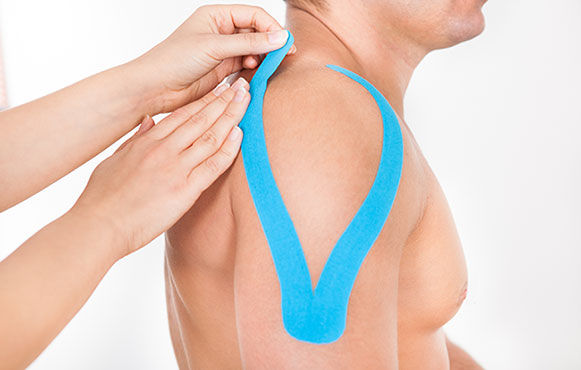
You’ve seen it on TV, at beach volleyball tournaments, soccer games and tennis matches: athletes wearing pink, blue, black and beige strips of tape all over their bodies. These strips are elastic therapeutic tape—commonly called kinesiology tape—and are purported to facilitate healing by helping athletes maintain proper blood and lymph flow, while also allowing freedom of movement.
Invented in the mid-‘90s by Kenzo Kase, a Japanese chiropractor, kinesiology tape is made of a hypoallergenic, latex-free material (although each brand’s material varies) and can stretch up to 140 percent of its resting length, which could help support and stabilize muscles and joints. However, unlike traditional rigid tape, the elasticity of kinesiology tape provides the added benefit of facilitating a natural range of motion, and the tension can be adjusted based on the needs of the athlete. Once applied to the skin, the tape returns to its resting length, forming convolutions (“pouches”) in the skin. These convolutions in the skin, along with the natural range of motion, is believed to increase metabolic activity and reduce pressure on subcutaneous blood and lymph vessels, promoting the body’s natural healing process and reducing pain. Pain reduction is a critical part of treatment for anyone, whether they are elite athletes or office workers.
What Does the Research Say?
But is kinesiology tape really a magical fix-it-all tape for those with musculoskeletal problems? Anecdotally, patients seem to respond well to kinesiology tape treatment. Most of the brands use a heat-activated adhesive, which enhances wearability of the tape over an extended period of time (three to five days, on average). The prolonged application of kinesiology tape seems to sustain the pain-reduction effects.

Evidence from scientific research on the use of kinesiology tape is a bit inconclusive. According to a systematic review of the existing literature on kinesiology tape by Montalvo, Le Cara and Myer (2014), individuals with musculoskeletal conditions did experience a reduction in pain, but the reduction was not clinically meaningful. In fact, they found that other treatment methods (even placebo tape) may provide similar pain-reduction results. However, some of the high-quality studies showed a more rapid pain reduction in patients who used kinesiology tape.
When it comes to other physiological characteristics, such as muscle extensibility and strength, joint position sense/proprioception and blood flow, the results were mixed, with some studies showing improvements while the others showed no improvements. It is worthwhile to note that the studies that investigated the effects of continuous kinesiology tape application over a 24-hour period yielded more positive results.The effects of kinesiology tape on blood/lymph flow are hardly addressed in the research, so there is still, however, no conclusive evidence.
Is it All a Placebo Effect?
So exactly how does kinesiology tape work? Is it just a placebo effect? Well, we don’t know yet. What we do know is that in various clinical and athletic settings, kinesiology tape has provided some pain relief to individuals, so they can perform more therapeutic rehabilitation exercises, which helps them return more quickly to their functional activities. When placed over the site of an acute injury, kinesiology tape appears to reduce the amount of discoloration and pain in less than 24 hours.
The exact mechanism by which kinesiology tape could work remains unknown. Tape manufacturers theorize that the convolutions in the skin created by the tape reduces the pressure on the lymph and blood vessels, thereby increasing the lymph and blood flow and promoting the body’s natural healing process. Again, there is no strong evidence on this. It’s not that the theory isn’t true—there just isn’t enough available research to prove this theory.
Another theory is that the directions of the pull of the tape can excite or inhibit the targeted muscles, which can help in restoring the muscle balance and natural joint range of motion. Again, there is nothing in literature that proves that the muscle spindles and Golgi tendon organs—the proprioceptors within the muscle tissue—can detect the direction of tape application and send the inhibitory or excitatory signals accordingly. A more likely theory is that cutaneous input from kinesiology tape enhances sensitivity to changes in the position of the limb or joint, so that an individual has more kinesthetic awareness and is more careful not to move his or her body in a harmful position. Kinesiology tape can also stimulate mechanoreceptors on the skin, which travel up the large-diameter fibers into the spinal cord and block the pain-generating (nociceptive) input.
Who Should Use Kinesiology Tape?
Overall, kinesiology tape seems to work the best for people who have chronic pain originating from musculoskeletal injuries, especially when the tape is applied continuously for more than 24 hours. If your clients are suffering from chronic tendon injuries, joint pain and instability, they may benefit from using kinesiology tape. It may also be effective on acute pain and inflammatory conditions, such as acute ligament sprains and muscle strains, but the results may vary from individual to individual.

The following are among the key points professionals trained in applying kinesiology tape take into consideration:
1. Always start and end on skin (not on tape) for more effective application (especially important when applying two or more strips).
2. Round off the edges to avoid unnecessary peeling of the tape.
3. Apply the tape in a stretched position, especially for the purpose of enhancing lymph and blood flow.
There are various schools of thoughts on the ideal direction of tape application (from the origin to insertion of a muscle or from the insertion to the origin), the amount of tension applied, the number of fans needed, the total number of strips needed and so on. The important factor is that the injured individual is comfortable with the tape, and that it doesn’t limit his or her function. Well-applied kinesiology tape should feel like the individual’s own skin.
Finally, it is important to remind individuals that kinesiology tape should be combined with other restorative strategies, including stretching, and rehabilitative and functional exercises, as recommended by the individual’s healthcare team.
Reference
Montalvo, A.M., Le Cara, E. and Myer, G.D. (2014). Effect of kinesiology taping on pain in individuals with musculoskeletal injuries: Systematic review and meta-analysis. The Physician and Sportsmedicine, 42, 2, 48-57.





 by
by 




